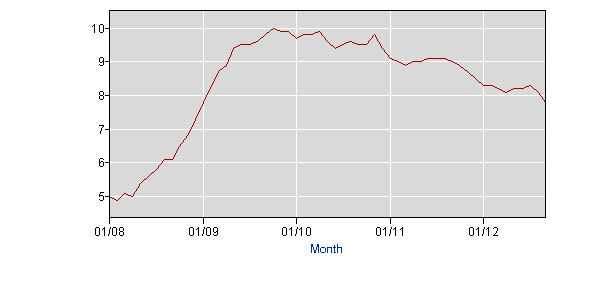Unemployment rises to 7.9 percent; 171K jobs added
(MoneyWatch) The U.S. economy added 171,000 new jobs in October and the unemployment rate inched up to 7.9 percent from last month's reading of 7.8 percent; August and September job creation totals were revised higher by a total of 84,000, putting average monthly job creation this year at 157,000, slightly ahead of the 2011 pace of 153,000.
Despite the uptick in the jobless rate, economists said the latest data show that the labor market is improving. The number of employed adults relative to the broader population, a key measure of the job market's health, rose to 58.8 percent, its highest level since August of 2009.
The number of people seeking full-time positions who are forced to work part-time also fell by 269,000 jobs. In another sign of progress, more people are voluntarily quitting their jobs, suggesting that they have more confidence about their chances of finding a better job.
"The October payroll survey showed a brighter picture of the labor market, both in faster headline job creation and in upward revisions to previous months," said Nigel Gault, chief U.S. economist for IHS Global Insight, in a statement. "There was good news in both construction and retail employment, consistent with the better news coming in from the housing market and with an improving consumer mood."
Although job growth has picked up in recent weeks, it is not accelerating fast enough to rapidly shrink unemployment. At the current rate of job-creation, the economy would not return to full employment until around the end of the decade.
Some data in the latest job report also highlight the economy's continuing struggles. The average number of hours employees work per week also were revised down to 34.4 in September and were unchanged in October. Growth in weekly hours indicates that employers may plan to boost hiring.
Employee pay also remains stagnant. The annual growth rate of average hourly earnings fell to 1.6 percent last month, a 26-year low, according to research firm Capital Economics.
Because this is the last jobs report before Election Day, it's worth noting that no president since Franklin Delano Roosevelt has won re-election with a jobless rate higher than 7.4 percent. FDR won a second term in 1936, when the rate was 17 percent, down from 22 percent when he was first elected. The last president since the Great Depression to win re-election with a rate of 7.4 percent or higher was Ronald Reagan in 1984.
The FDR example may be a more appropriate template for this election, because while the recession suffered in the early 1980s was severe, it was not associated with a systemic banking crisis. According to economists Carmen M. Reinhart and Kenneth S. Rogoff, authors of "This Time Is Different: Eight Centuries of Financial Folly," the recession which began in December 2007 was the first since the Great Depression where the U.S. economy experienced a systemic crisis. Before that, notable systemic post-Civil War financial crises occurred in 1873, 1893 and 1907.
Clearly, the Great Depression dwarfs the recent Great Recession. In the four years between 1929 and 1933, the United States economy shrunk by one-third and unemployment soared to 25 percent, from 3 percent. The Great Recession inflicted far less damage on the economy, with output shrinking 4.7 percent from the start of the recession in December 2007 until it ended in June 2009. Just before the beginning of the recession, the unemployment rate was 5 percent and it peaked at 10 in October 2009, before heading lower to today's 7.9 percent.
The jobs market has been a disappointment over the past four years. From 2009 to early 2010, millions of jobs were lost before the economy steadied and slowly, job creation crept up. Unfortunately, of the 8.8 million jobs lost during the financial crisis, only about half have been added back. Still, the old Wall Street chestnut "the trend is your friend" may be at play in this election, as it was in 1936.
If voters view the Great Recession as an extreme event, which no president since FDR had to confront, and they focus on the slow improvement to the labor market, then Obama will win. If voters believe that Obama's policies were not the right ones to turn around the jobs market faster, despite the unique circumstances, they will elect Romney.
October jobs:
-- Jobs created: +171K (Sep: revised to +148K from +114K, Aug: revised to +192K from +142K)
-- Private jobs created: 184K
-- Government jobs lost: -13K
-- Unemployment rate: 7.9% (from 7.8%)
-- Broad unemployment rate: 14.6% (includes the official rate plus "marginally attached workers," those who are neither working nor looking for work, but say they want a job and have looked for work recently; and people who are employed part-time for economic reasons, meaning they want full-time work but took a part-time schedule instead because that's all they could find)
-- Total unemployed: 12.3 million
-- Long-term unemployed: 5 million, representing 40.6 percent of the total unemployed
-- Average duration of unemployment: 40.2 weeks (high level for 2012)
-- Participation rate: 63.8 ( below the 66% to 67% rate that was normal over the last 20 years; 2/3 of recent decline is due to demographics)
-- Average work week: 34.4
-- Hourly earnings: $23.58 (Over the past 12 months, up 1.6%)
-- Retail: +36K
-- Health services: +31K
-- Leisure/Hospitality: +28K
-- Construction: +17K
Editor's note: CBS MoneyWatch initially published an Associated Press story on the unemployment report, which we have since replaced with this staff-written article. You can find the initial AP report and reader comments here.
